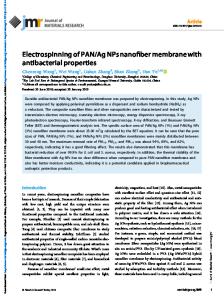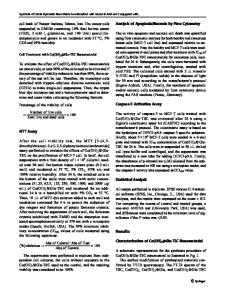Phosphate functionalized poly(vinyl alcohol)/poly(acrylic acid) (PVA/PAA): an electrospinning nanofiber for uranium sepa
- PDF / 3,077,429 Bytes
- 12 Pages / 595.276 x 790.866 pts Page_size
- 46 Downloads / 359 Views
Phosphate functionalized poly(vinyl alcohol)/poly(acrylic acid) (PVA/ PAA): an electrospinning nanofiber for uranium separation Jinhua Xie1 · Riwen Lv2 · Hong Peng2 · Jiali Fan2 · Qinqin Tao1,2 · Ying Dai1,2 · Zhibin Zhang1,2 · Xiaohong Cao1,2 · Yunhai Liu1,2 Received: 4 May 2020 © Akadémiai Kiadó, Budapest, Hungary 2020
Abstract With the aim of capturing uranium from water mediums phosphate functionalized poly(vinyl alcohol)/poly(acrylic acid) (PVA/PAA) nanofiber (PVA/PAA-PO4) was firstly fabricated using the electrospinning method of fast process and high efficiency. The as-prepared PVA/PAA-PO4 showed excellent water stability and tensile strength besides competitive uranium uptake capacity of 277.78 mg/g. Phosphate played a vital role in the structure of PVA/PAA-PO4 for the attractive uranium uptake capacity. PVA/PAA-PO4 was characterized by SEM, XPS, FT-IR and omnipotence machine. The effects of pH, ionic strength, oscillation time, initial uranium concentration and temperature on the uranium adsorption with PVA/PAA-PO4 were studied. The elution with different kinds of acids was conducted and the reusability through the adsorption-desorption cycle test was carried out. The work provided a promising candidate for uranium separation from aqueous solution. Keywords Uranium ions · Adsorption isotherms and kinetics · PVA/PAA nanofiber · Electrospinning process
Introduction Nuclear energy associated with cleanliness and high efficiency is widely welcomed in some developed country such France, Japan and USA, etc. and gains much attention in some developing country for example China and India. Radioactive wastes in gas, solid and liquid state always go with the nuclear fuel cycle [1]. Entry deterrence of the wastes into the environment is vital in view of safeguarding human environment. Uranium regarded as one of the most important ingredients for nuclear energy is often marginally transferred into radioactive wastes, especially in aqueous effluent. With the density of 18.95 g/cm3 the heavy metal toxicity of uranium is prominent. Two main uranium nuclides such as * Ying Dai [email protected] * Yunhai Liu [email protected] 1
State Key Laboratory of Nuclear Resources and Environment, East China University of Technology, Nanchang 330013, Jiangxi, China
School of Chemistry, Biological and Materials Sciences, East China University of Technology, Nanchang 330013, Jiangxi, China
2
uranium-235 (t1/2 = 7.038 × 108 yrs) and uranium-238 (t1/2 = 4.468 × 109 yrs) are able to result in long-term damage to biosphere through direct decay and indirect decay associated with the radioactive radon [2–4]. Owning to the above property uranium, once exposure, would bring irreversible injury to heart, kidneys, liver and reproductive organs of human beings, which could have been avoided by strong legal management and effective techniques [5, 6]. Separation and enrichment of uranium is one of the valid ways to constrain uranium in the nuclear fuel cycle. Chemical precipitation [7], adsorption [8], electrochemistry [9], ion exch
Data Loading...











